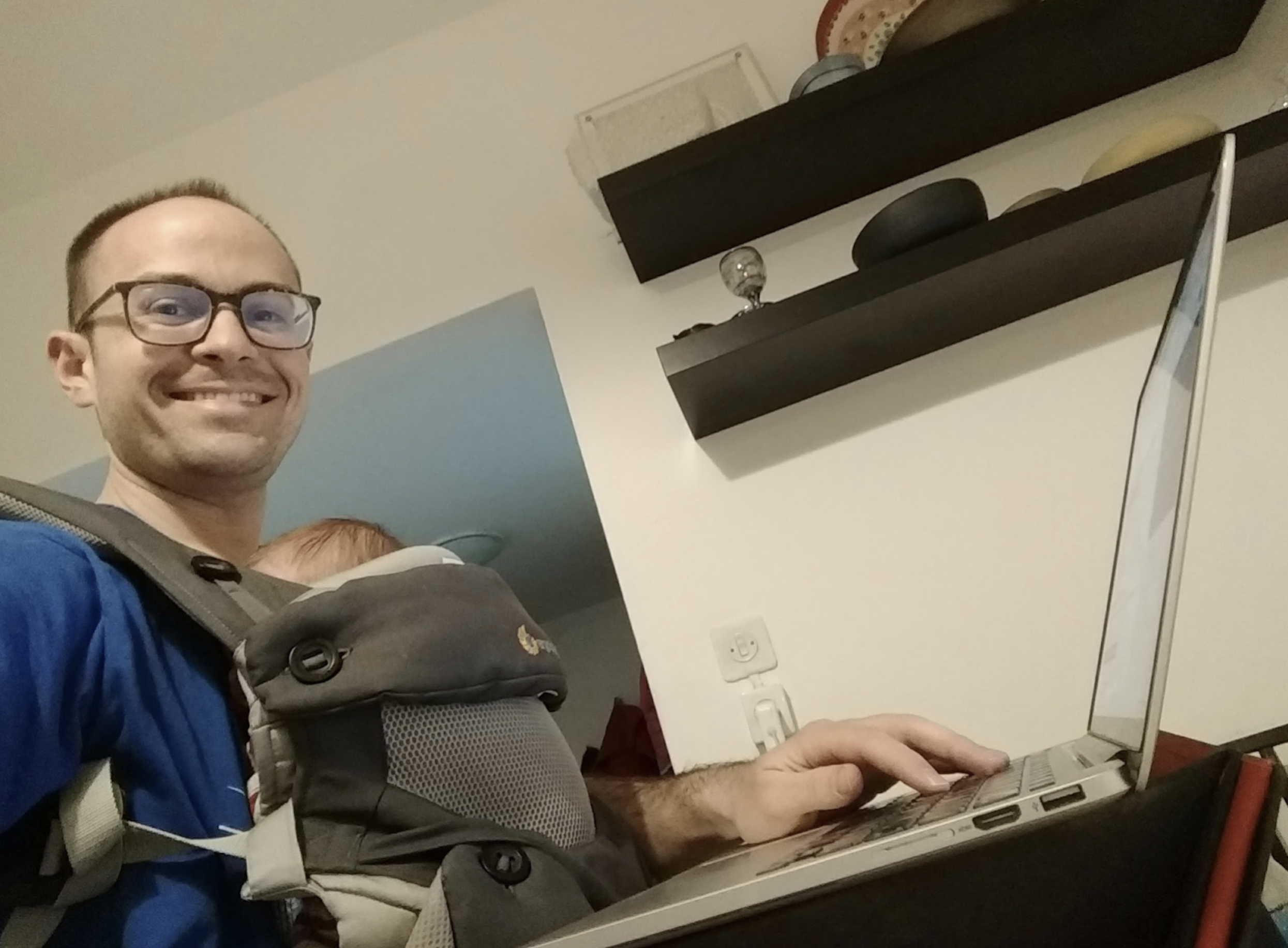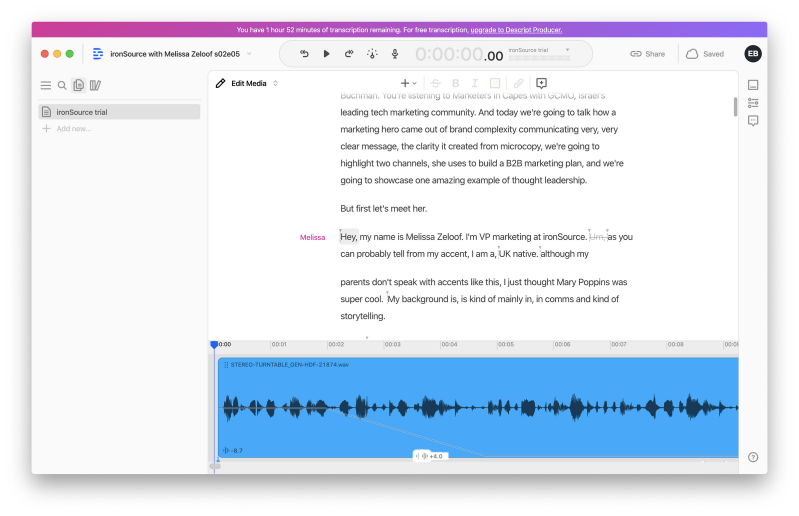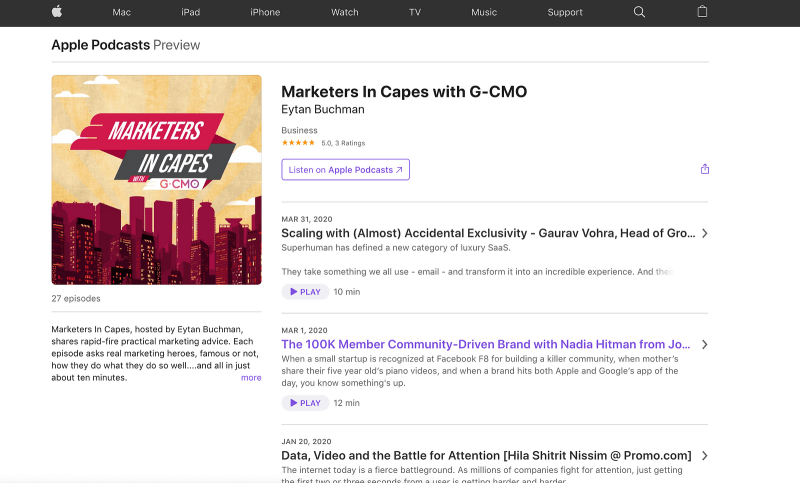Lessons in Launching a Global Marketing Podcast
tldr
In this post, I take a look at what I wish I knew when starting a podcast, the technical process, some hard-learned tips around the content and format, and some important takeaways going forward. Hope this helps you get your podcast off the ground! This article also appears on the Aleph.vc blog._If you’re reading this, you may think you’re late for the podcast party. You are.
But you’re not too late for the GOOD podcast party.
There are far, far fewer people in that one.
Over the last two years, my marketing podcast, Marketers in Capes , has grown into a fairly popular podcast (especially among my two to three friends and my mother), with thousands of listeners. But it started with a puddle of tears. More on that soon.
Twenty-two episodes in, I’ve interviewed some amazing companies, from Mixpanel to Drift, Superhuman to Volvo. Every month, I get double-digit inbound pitches.
I’m having a good time.
So I’m sharing my origin story. More importantly, I’m sharing the recording workflow, the smack-me-in-the-face lessons I’ve learned, and some things I know I still need to learn.
Building a podcast is not hard. If you’re a marketer behind a brand that can drive educational value, there are few platforms that can generate as much concentrated and targeted exposure as podcasts.
The Origin Story
On February 26, 2018, Marketers in Capes was born, just two and a half weeks after the birth of my second daughter, Noga. See, for her first three months, she wouldn’t stop crying. Except when she was strapped to someone’s chest. Frequently mine. Thanks, Uppababy.
My core contribution to domestic sanity was strapping her on and swaying for half the night, staring at a screen on a jerry-rigged standing desk.

Me recording with my daughter.
And, while I love marketing Freightos, there’s only so many hours in a day you can spend working on anything , even freight.
Enter Marketers in Capes, nèe Two Minute Marketing
Before Noga came along, I read Walter Isaacson’s da Vinci bio. I wanted to take da Vinci’s inquisitiveness, apply it to marketing, and podcast-atize it. But I had zero patience for long-form pontification. With my time at a premium post-Noga, this was doubly true.
The Differentiation
So I decided to start a marketing podcast.
It would be short-form and heavily edited to get right to the point. And it would explore concepts I found interesting, not the same glory stories everyone was doing.
Sound familiar? It is. If you’re planning your own podcast, think about differentiation. There are a lot of podcasts out there and you need to have your own angle. Format, content, or tone — it needs to be different.
My differentiation was chosen for me. It’s hard to interview someone with a baby screaming in the background. This forced a format choice, which, in turn, shaped the podcast.
Two and a Half Things That Made It Possible
First, the format.
Instead of interviewing people along with a child screaming bloody murder, I emailed them questions and asked them to record answers at their convenience. When Noga was conked out in the baby carrier, I recorded my editorial comments, talking in the calmest voice I could. I swear that in some of the earlier episodes, you can hear her breathing in the background. A little editing and bam — I was done.
Second, to thine own self be an editor. Being able to do your own editing is liberating. Imagine if you could bake but couldn’t measure. Independent editing lets you play around, helping you shape your own product. Plus, with products like Descript, literally anyone can do it.
Two and a half (since I only picked up on this halfway through). Every episode should tell a story. You have 30 seconds to tell a user why they should listen. Which means a super concise, thirty-second rendition of why they should stick around, ideally told as a story (“over the next five minutes, you’ll learn how X battled a marketing dragon and won the lead princess’s heart with SEO”).
And One Big Change I Made Along The Way
As it turned out, format was a failure as a differentiator. It helped, but it wasn’t enough. So at some point, I sat down and wrote a short list of what made me different:
- Length : I value listeners’ time. If it can be said in 30 seconds, don’t take five minutes.
- Tone : I like when people speak to me in human. Which means that I’ll make jokes.
- Speakers : I don’t care about seniority. I care about if the person can say something interesting. As a matter of fact, I tell interviewees that if I show the episode to a friend before publishing and it gets a bad review, I’ll trash it.
- Level : It’s hard to reach the balance between beginner content, which is more accessible, and advanced, which has a smaller audience. I decided to go with intermediate and up, which means that I kill everything (EVERYTHING) that is obvious to anyone who has been around the block.
- I don’t do performance marketing. Period.
Together, these qualities create a fairly unique show.
So having moved beyond the big “Why Are You Different Lesson” of 2019, now’s a great time to take a knee and talk about what’s worked for me, what hasn’t, my setup and the lessons I’ve learned along the way.
So here goes.
Lessons On The Technical Side
Stop using technical hurdles as an excuse for not launching. Just stop. This is all it takes:
- Find the person to interview. This is the hard part, not recording. Remember how many articles there were about Yuval Noah Harari after Sapiens? Don’t be that cliché. A unique angle almost always starts with a unique candidate to interview.
- Cold email the person with a solid pitch. More on that below.
- Use Meetingbird to schedule a time. It saves back and forth on coordinating, ensuring that they don’t just run out of patience before you ever speak.
- Record with Zencastr, a browser-only tool that records each person on a separate track, making post-processing way easier. When prerecording, I just ask people to use their cellphone memo app.
- Transcribe with otter.ai. This helps read through the interview, highlight interesting parts, and, most importantly, restructure it so that the interview tells a real story.
- Dump everything into a text editor to write my side of the interview.
- Record my side.
- Edit very briefly with some basic sound cleaning and an intro/outro, all with Screenflow or (much more frequently), with Descript.
- Upload track to Auphonic for normalizing.
- Upload to Anchor, which makes sure it gets to Apple Podcast, Google, and…everywhere.
- Add links and transcription (otter.ai again) on my WordPress site, buchman.co.il, so I can share using only one link instead of sending Android users an Apple Podcast link.
- Create basic graphics using Sketch. Your podcast graphic is critical in order to stand out. Invest a little in this, or find someone on Upwork to do this for you. Make sure the words are BIG — they are going to be on a small screen.

Descript — this stuff is magic
The entire process usually takes me about two to four hours per episode. The hardest part is just finding people or brands that genuinely make me curious. Sometimes it starts with the person. Other times, I wake up curious about a topic and look around until I find someone who can scratch the itch.
Which leads to yet another tip. Become inquisitive when reading articles, watching TV, and talking to friends. Great reporters have an ear for a story; you need to exercise that muscle.
On Recording…
I started this with an iPhone headset. I’ve graduated to a $99 Blue Yeti Nano but honestly, use a quiet room, a normal headset, and you’re golden. That’s it!

Look no further than this mic, the Blue Yeti.
When it comes to editing, the best way I’ve ever learned to edit video or audio is by watching someone while they were doing it. Call it a five-hour apprenticeship. It’s worth it.
The Really Meaty Lessons
While working on Marketers in Capes , I learned some things the hard way. And because it’s ultimately just a side project, there are some things I’ve learned and still haven’t fixed. Let’s start with what does work.
Lessons Learned: What Has Worked
- Just ship it. For the love of content, put it out there. Hit publish. Do it. Do it again. The most perfect unpublished episode is worthless compared to an imperfect published episode.
- Content quality over audio quality. Get the right interviewee or story. Very little else matters (listen to the audio quality in the “I Have A Dream” recording). In one of my favorite episodes, I interviewed Eric Kallman, the genius behind Old Spice’s “Smell Like A Man, Man” ad. We had to revert to my cellphone, complete with crappy reception. The quality was ATROCIOUS. But I’ve never gotten more positive feedback from an episode. Some people gave me a little crap for the quality, but I promise you this — they listened to every second.
- Ask questions. People answer. The best form of outbound marketing is still a personalized email that generates engagement. When I want to learn something new, I find the three best people in the world doing it, use Clearbit to get their emails, and cold email them. I’m batting over 70% on response rates. This strategy also got me my job at Freightos. Trust me, you can ask anyone anything. You’ll be shocked by how many Fortune 500 CMOs will answer. My first interview was with David Cancel, the CEO at Drift. My second was with Rand Fishkin, the legend from Moz and SparkToro. I had no previous episodes to reference and no connections — just personalized outreach. It worked.
- Lower the ask. At the same time, be super-specific and realistic. The main reason I was able to get answers is that the full investment I was going for was ten minutes or so, at the subjects’ own convenience. Be clear about what you want and remember that the cost/benefit for the interviewee is not just a function of what benefit you drive for them. For example, here’s the email I used for reaching out to David Cancel of Drift:
David, Huge fan of Drift (especially how you’ve built and communicate the brand). I was intrigued by the launch of the Drift Inner Circle. It exudes a passion for customer success, not just selling, and it’s rare for a CEO to be so hands-on. I’m recording a podcast about it (yea, I liked it that much) and was hoping that you might have 60 seconds to record a quick audio soundbite about why you chose to launch Inner Circle and the importance you assign to helping customers succeed. I know it’s a big ask — just want to show some of my Drift ? Eytan
4. Set a high listening bar. Be your own worst critic. I have invested hours in an episode and then trashed it. There are mountains of crappy content online; don’t create more. And don’t disrespect your hard-earned audience with it. It’s a lot easier to lose fans than to gain them.
5. Evoke emotions. Help your audience evolve from A to B. Don’t promise features (Marketing insights in two minutes…). Promise a marketing evolution. After realizing that one morning when waking up, I changed the name of the podcast to something that I felt communicated the role of marketing superheroes. It made a big difference.
6. Tell a story. I used to try to cram as many insights as possible into each episode. Until I remembered that people don’t consume content that way. One of my best episodes ever, which even killed it with Reddit users, the most picky users in the world, was a story of how a budget-strapped Volvo destroyed a major competitor with a subversive social media campaign. It was a legit story, with a struggle, a hero, a villain, and a win. Story: 1; Laundry list of tips: 0.
7. Persistence. It’s not easy. With Superhuman, it took half a year of outreach to get the interview. But I genuinely wanted to know the backstory. So I stuck with it.
8. Get out of the echo chamber. While I wouldn’t pass up the opportunity to interview Reid Hoffman or Bill Gates, their insights are out there. The most gratifying episodes are not the ones you’ll come across in other podcasts. They’re stories about how to brand a fertility clinic or newsjack with soybeans.
9. Get comfortable with the technical. For me, as a marketer, I find technical comfort liberating. I’m not a professional video or audio editor. I can’t consult on technical SEO. I can’t code a (functional) product. And I can’t create a comprehensive business model by myself. But I feel comfortable trying and definitely know enough to be either an educated consumer or someone who can experiment enough until I get there myself. If you’re a marketer, get your hands dirty. It will break the shackles.
10. Put yourself out there. Every episode I publish is scary. Partially because sharing on my social network is still a core distribution channel, but also because, by definition, I reach out to MY marketing heroes. Which means that they’ll hear me making an idiot of myself — or worse — making idiots of them. But nothing ventured, nothing gained.
Lessons I (Still) Need to Learn
So yeah, twenty-some odd episodes in, I’m feeling pretty good about this. My daughter isn’t crying herself to sleep anymore and, while I’m busy, Marketers in Capes is still a great escape. And there’s still more to learn.
- Cadence. I still publish the episodes on a random schedule. I know that the lag lowers my user base. It’s hard to build up excitement when you’re waiting for a month between each episode.
- Effective cross-platform distribution. My core distribution channels are personal social media accounts, the email list I’ve built up for this (low four digits), my partnership with G-CMO, and the person I’m interviewing. Since this is a low-time investment, I haven’t done enough about pulling together the right creatives for each channel. And content without distribution is barely worth the bits it’s recorded on.
- Reviews. I haven’t cracked the code on how to get more reviews, which I’m sure is keeping me low on most podcast platforms. I’ve tried begging, but that only got the knees of my pants dirty.
- Defined target audience. This is probably the most glaring weakness. It’s hard for me to nail down exactly who my target audience is. I’m mostly inspired by Tim Urban ( Wait But Why), who says that he writes as if he’s talking to a stadium full of himself. I record my podcasts as if I’m trying to talk to myself. This is either a huge advantage or huge weakness. Time will tell.
- Flow. One of the biggest drawbacks of my recording method is that sometimes the flow for an asynchronous interview just doesn’t work. Recently, I’ve been conducting real interviews and then chopping them up using the same editing process.
 3 reviews? WTF. Help me fix it.
3 reviews? WTF. Help me fix it.
Just to wrap this up…
As a content and messaging delivery channel, podcasts can be an incredible differentiator.
But only if you have something different to say.
Of course, if you’re approaching this for your business, follow the same rules you would follow for any content:
- Do you have something unique to say? The world does not need yet another derivative podcast in your space.
- Do you have a unique angle?
- Hardware isn’t a real impediment; time is. Do you have the time and bandwidth to invest in maintaining a podcast?
- What distribution channels do you have?
- Catalog the existing relationships that you have for interviews. Who can you tap in order to drive fresh insights?
Got it?
Now go listen to Marketers in Capes.